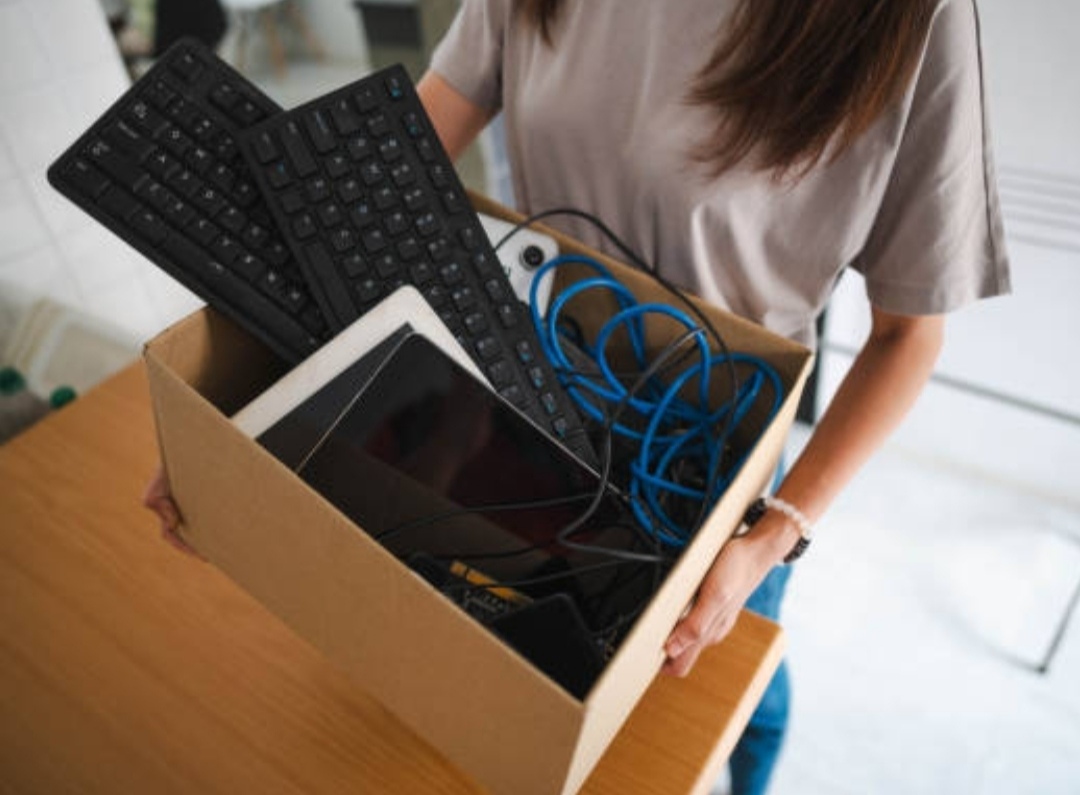Disposing Electronics Waste Safely
In today’s fast-paced digital world, electronic devices have become an essential part of our daily lives.
From smartphones and laptops to televisions and kitchen appliances, we rely on technology more than ever.
However, as technology advances, so does the issue of electronic waste (e-waste).
Millions of electronic devices are discarded every year, contributing to a growing global waste crisis.
Improper disposal of electronics harms the environment, wastes valuable materials, and poses serious health risks.
That’s why it’s crucial to understand how to dispose electronics waste safely and responsibly.
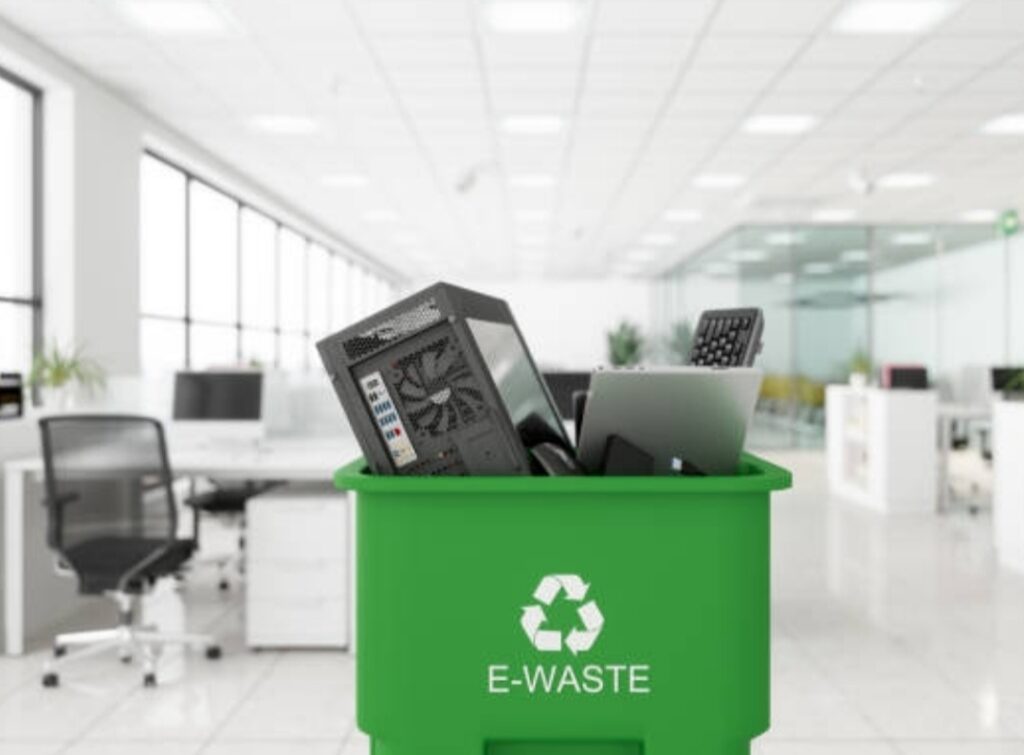
Why E-Waste is a Global Concern
Many people are unaware of the dangers of electronic waste.
When old gadgets and appliances are thrown in the trash, they often end up in landfills or are illegally dumped in developing countries.
This leads to severe environmental and health problems, including:
- Toxic Waste Contamination: Electronics contain harmful substances like lead, mercury, and cadmium, which can pollute the soil and water if not properly handled.
- Air Pollution: Burning e-waste releases dangerous chemicals into the air, leading to respiratory diseases and other health issues.
- Resource Depletion: Electronics contain precious metals such as gold, silver, and copper that can be recycled and reused.
However, when these materials are thrown away, they are lost forever, increasing the demand for mining and environmental destruction.
By adopting eco-friendly disposal methods, we can minimize pollution, conserve natural resources, and protect human health.
Understanding the Importance of Responsible Electronics Disposal
Proper e-waste management is essential for a sustainable future.
With technology evolving rapidly, electronic devices become outdated quickly, leading to more discarded gadgets every year.
The good news?
There are several safe and environmentally friendly ways to dispose of unwanted electronics:
✔ Recycling through certified e-waste programs
✔ Donating or selling used electronics
✔ Participating in manufacturer take-back programs
✔ Repairing devices instead of replacing them
By making conscious decisions about how we handle e-waste, we can all contribute to a cleaner planet and a healthier future.
What You’ll Discover in This Guide
This comprehensive guide will walk you through everything you need to know about e-waste disposal, including:
✅ The environmental impact of electronic waste
✅ The best methods for recycling electronics safely
✅ Where to find certified e-waste recyclers near you
✅ How to donate or trade-in old electronics
✅ Common misconceptions about e-waste disposal
Whether you’re looking for ways to get rid of an old laptop, a broken phone, or outdated household appliances, this guide will provide clear, actionable steps to help you dispose of electronics responsibly.
📢 Ready to take action? Keep reading to discover the best ways to handle your e-waste!
Understanding the Importance of Safe Electronics Disposal
The world generates over 50 million metric tons of electronic waste (e-waste) every year, and this number is rising rapidly.
With the increasing reliance on smartphones, computers, and other electronic devices, it’s crucial to understand how to dispose electronics waste safely to prevent environmental and health hazards.
Electronics contain hazardous materials such as lead, mercury, cadmium, and brominated flame retardants, which can seep into the environment if not disposed of properly.
On the other hand, responsible e-waste recycling helps conserve valuable resources, reduce pollution, and promote a more sustainable future.
Let’s take a deeper look at the impact of improper e-waste disposal and the benefits of safe recycling.
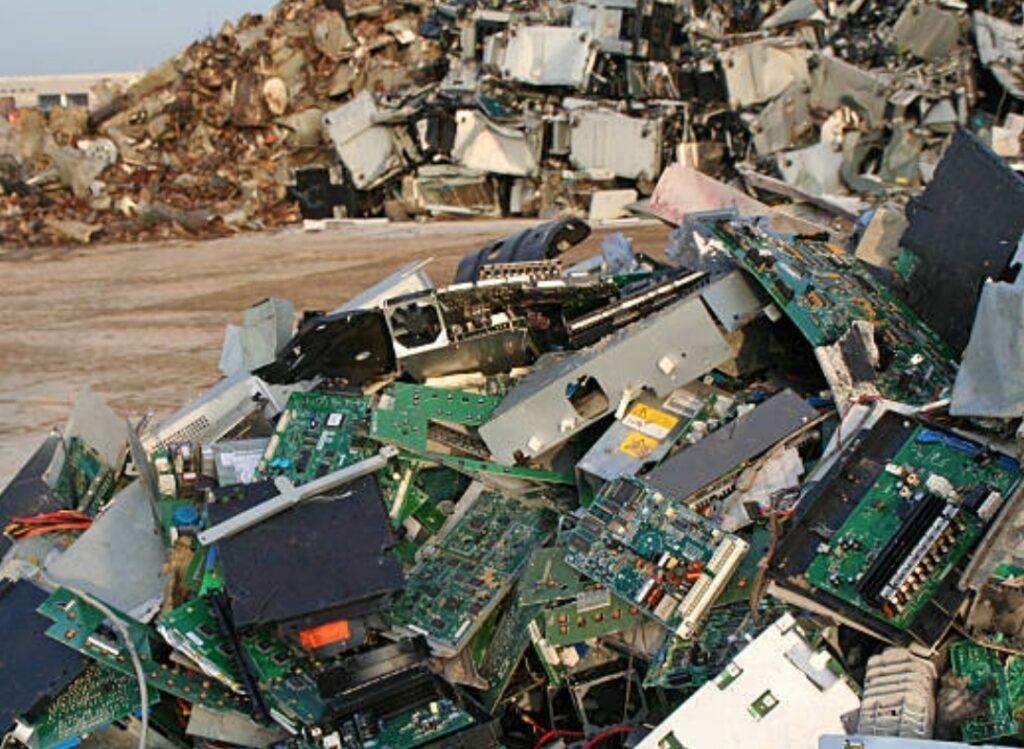
Environmental Impact of Improper E-Waste Disposal
E-waste is one of the fastest-growing waste streams globally, and when electronics are discarded irresponsibly, they pose severe environmental threats.
Here’s how improper e-waste disposal affects our planet:
Soil Contamination and Groundwater Pollution
When electronic devices end up in landfills, they don’t simply decompose like organic waste.
Instead, hazardous chemicals slowly leach into the soil, contaminating the surrounding environment.
- Heavy metals like lead and cadmium can accumulate in the soil, making the land infertile and unsuitable for agriculture.
- Over time, these toxic substances seep into groundwater sources, which can lead to severe health issues when consumed by humans and animals.
According to environmental studies, over 70% of toxic waste in landfills comes from discarded electronics.
This highlights the urgent need to dispose of electronic devices responsibly.
Air Pollution from Improper E-Waste Disposal
Another major concern is air pollution caused by burning e-waste.
Many people, especially in developing countries, burn old electronics to extract valuable metals like copper and gold.
However, this process releases toxic fumes, including:
- Dioxins and furans, which contribute to respiratory diseases
- Mercury vapor, which is harmful to the nervous system
- Carcinogenic compounds, increasing cancer risks
E-waste burning is a leading cause of air pollution in many developing nations, impacting not only the environment but also the health of workers exposed to these fumes daily.
Harmful Effects on Marine Ecosystems
Improper disposal of electronic waste also threatens aquatic life.
Many discarded electronics end up in oceans and rivers, either through illegal dumping or runoff from landfills.
Once in the water, toxic chemicals dissolve, affecting marine ecosystems:
- Mercury poisoning in fish, which then enters the human food chain
- Plastic components from electronics breaking down into microplastics, harming marine life
- Disruption of aquatic biodiversity, leading to declining fish populations
With millions of tons of e-waste entering water bodies every year, proper disposal methods are more important than ever.
📌 Did You Know?
More than 40% of heavy metals found in landfills come from e-waste, making it one of the most hazardous types of waste.
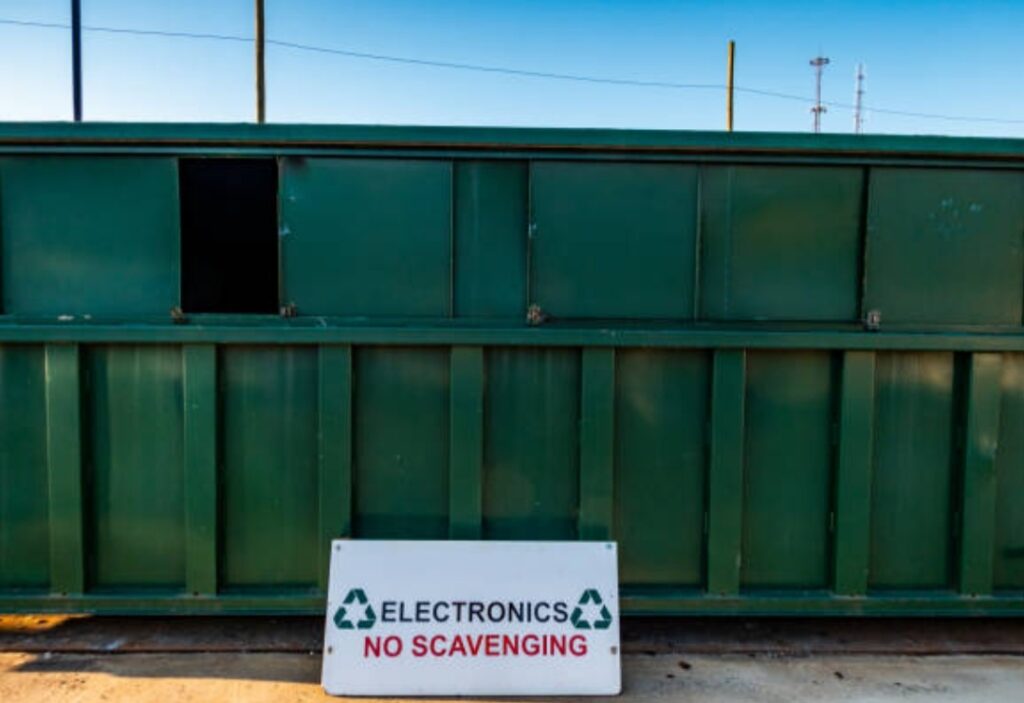
Benefits of Responsible E-Waste Recycling
Properly disposing of electronics doesn’t just prevent environmental damage—it also offers numerous benefits to society, businesses, and individuals.
Conservation of Natural Resources
Electronics contain precious materials like:
- Gold, silver, and palladium used in circuit boards
- Copper and aluminum found in wiring and casings
- Rare earth elements crucial for battery and screen production
By recycling old electronics, these valuable resources can be recovered and reused, reducing the need for new mining activities.
Mining is highly destructive to the environment, leading to deforestation, soil erosion, and water pollution.
✅ Fun Fact:
Recycling 1 million mobile phones can recover 75 pounds of gold, 770 pounds of silver, and 35,000 pounds of copper!
Reduction of Electronic Waste in Landfills
The more we recycle electronics, the less waste ends up in landfills.
Currently, only 20% of e-waste is properly recycled worldwide, meaning 80% of discarded electronics pollute our planet.
By choosing certified recycling programs, we can:
- Significantly reduce landfill waste
- Decrease soil and water contamination
- Support a circular economy, where materials are reused instead of discarded
This is why learning how to dispose electronics waste safely is critical for reducing e-waste buildup.
Energy Savings and Lower Carbon Footprint
Recycling e-waste saves massive amounts of energy compared to manufacturing new devices from raw materials.
For example:
- Recycling aluminum saves 95% of the energy needed to mine new aluminum
- Recycling steel saves 60-74% of energy compared to new production
- Using recycled plastic in electronics can cut down carbon emissions by up to 90%
By properly recycling electronics, we reduce greenhouse gas emissions, helping combat climate change.
What You Can Do Today!
Now that you understand the importance of responsible electronics disposal, it’s time to take action!
🚀 Here’s what you can do right now:
✔ Check if your city offers e-waste recycling programs – Many local governments host free drop-off events for old electronics.
✔ Find manufacturer take-back programs – Brands like Apple, Samsung, and Dell accept old devices for safe recycling.
✔ Donate working electronics – Schools, charities, and shelters often accept old computers and phones for reuse.
✔ Look for certified e-waste recyclers – Organizations like e-Stewards and Earth911 help locate responsible recycling centers.
🔹 Every small action makes a big difference!
Let’s work together to reduce e-waste, protect our planet, and create a more sustainable future.
🔥 Ready to take the next step?
Explore responsible e-waste recycling programs in your area today! 🚀
Preparing Your Electronics for Disposal
Before you dispose of your electronics safely, it’s crucial to take a few preparatory steps to ensure that your personal data is erased and your device is ready for responsible recycling.
Many electronic devices store sensitive personal information, including:
- Usernames and passwords
- Banking details and credit card information
- Photos, messages, and personal files
- Work-related documents and confidential data
Failing to wipe your device properly can put your personal information at risk, even if you think it’s broken or unusable.
In this section, we’ll explore the best practices for erasing data from smartphones, tablets, laptops, and computers before recycling, donating, or disposing of them.

Data Security Measures Before Disposal
How to Wipe Data from Smartphones and Tablets
Your smartphone or tablet contains highly sensitive data, from personal photos to stored passwords and financial information.
Before getting rid of your device, it’s essential to ensure all your personal data is erased permanently.
Follow these step-by-step instructions to wipe your smartphone or tablet safely:
Step 1: Backup Your Important Data
Before resetting your phone, make sure you have saved any important files, contacts, and messages.
- iPhone Users: Use iCloud or iTunes to back up your data.
- Android Users: Use Google Drive, Samsung Cloud, or a local computer backup.
If you have important documents or media files, consider transferring them to an external hard drive or cloud storage.
Step 2: Remove External Accounts and Services
To prevent issues with device activation lock, be sure to sign out of all linked accounts:
- Apple users: Sign out of iCloud, iTunes, and App Store
- Android users: Remove Google accounts and Samsung accounts
Failure to do this may result in your device remaining linked to your accounts, making it unusable for someone else.
Step 3: Perform a Factory Reset
Now that you’ve backed up your data and removed linked accounts, it’s time to erase everything from your device.
- For iPhones & iPads:
- Go to Settings > General > Transfer or Reset iPhone
- Tap Erase All Content and Settings
- Enter your passcode and confirm
- Go to Settings > General > Transfer or Reset iPhone
- For Android Devices:
- Go to Settings > System > Reset Options
- Select Erase All Data (Factory Reset)
- Confirm and wait for the reset to complete
- Go to Settings > System > Reset Options
Step 4: Remove SIM and SD Cards
Even after a reset, your SIM card and external SD card may still contain personal data.
Before disposal, remove them and either reuse or destroy them.
📌 Pro Tip: If your device is old but still functional, consider donating it to a charity, school, or recycling program instead of throwing it away.
How to Wipe Data from Computers and Laptops
Computers and laptops store a vast amount of personal and sensitive data, making it crucial to take extra precautions before disposing of them.
Here’s how to properly erase data from your computer or laptop:
Step 1: Backup Important Files
Before wiping your computer, transfer any important files to an external hard drive, USB, or cloud storage.
If you’re upgrading to a new device, use Windows OneDrive, Mac’s Time Machine, or Google Drive for seamless backups.
Step 2: Sign Out of All Accounts
Ensure you log out of:
- Google accounts (Gmail, YouTube, Chrome Sync, etc.)
- Microsoft or Apple accounts
- Cloud storage (Dropbox, iCloud, OneDrive, etc.)
This prevents future users from accessing your accounts, even if they recover your hard drive.
Step 3: Securely Wipe Your Hard Drive
Performing a simple “delete” command is NOT enough—deleted files can still be recovered with specialized software.
Instead, use disk-wiping utilities that overwrite your data completely:
- For Windows Users:
- Use Windows Reset:
- Go to Settings > Update & Security > Recovery
- Click Reset this PC > Remove Everything > Fully Clean the Drive
- Go to Settings > Update & Security > Recovery
- For extra security, use third-party tools like DBAN (Darik’s Boot and Nuke) to wipe the disk completely.
- Use Windows Reset:
- For Mac Users:
- Restart your Mac and hold Command (⌘) + R to enter macOS Recovery Mode
- Open Disk Utility and select your hard drive
- Click Erase, choose APFS or Mac OS Extended (Journaled) format, and confirm
- Restart your Mac and hold Command (⌘) + R to enter macOS Recovery Mode
Step 4: Physically Destroy the Hard Drive (For Maximum Security)
If you’re extremely concerned about data security, consider physically destroying your hard drive.
Even after wiping, data recovery professionals can sometimes retrieve sensitive information.
Here’s how to safely destroy a hard drive:
- Use a drill: Drill several holes through the drive to make data retrieval impossible.
- Smash it with a hammer: Breaking the platters inside the drive prevents recovery.
- Use a shredder: Industrial shredders can completely destroy hard drives.
🔥 Warning! Always wear protective eyewear and gloves when destroying a hard drive to avoid injury.
📌 Pro Tip: If you prefer not to destroy the drive yourself, look for certified e-waste recyclers who offer secure data destruction services.
Secure Your Data Before Disposal
Before disposing of your electronics, always ensure that all personal data is completely erased.
✅ Smartphones and Tablets: Perform a factory reset, remove SIM/SD cards, and unlink cloud accounts.
✅ Laptops and Computers: Use disk-wiping software, sign out of all accounts, and physically destroy the hard drive if needed.
By following these steps, you can safeguard your sensitive data while ensuring your electronic waste is disposed of responsibly.
🔹 Next Step: Now that your device is wiped, learn about the best ways to recycle electronics in the next section! 🚀
Options for Disposing of Electronics Safely
As technology advances, electronic devices become outdated quickly, leading to an increase in electronic waste (e-waste).
Many people don’t realize that improperly disposing of electronics can lead to toxic chemical leakage, pollution, and health hazards.
If you’re wondering how to dispose electronics waste safely, there are several responsible options available.
From manufacturer trade-in programs to certified recycling centers, these methods help reduce e-waste and protect the environment.
Let’s explore the best ways to safely dispose of old electronics while ensuring they are either recycled or repurposed.

Manufacturer Take-Back and Trade-In Programs
Many electronics manufacturers offer take-back programs that allow customers to return their old gadgets for proper recycling or refurbishment.
These programs ensure that discarded devices are handled in an eco-friendly manner, minimizing harmful environmental impact.
Benefits of Manufacturer Programs
Opting for a manufacturer trade-in or recycling program comes with several benefits, including:
✅ Eco-Friendly Recycling – Manufacturers have specialized recycling processes to safely extract and reuse valuable materials like metals, plastics, and circuit board components.
✅ Earn Credit Toward New Purchases – Some companies offer trade-in credit or discounts when you return your old device, making upgrades more affordable.
✅ Convenience – Many companies provide prepaid shipping labels or in-store drop-off options, making it easy to recycle your device.
✅ Proper Disposal of Hazardous Materials – Electronics contain toxic substances like lead, mercury, and cadmium, which manufacturers dispose of safely through their programs.
✅ Extends Product Lifecycle – If a device is still functional, it may be refurbished and resold, reducing electronic waste and helping others access affordable tech.
How to Participate in Manufacturer Take-Back Programs
Participating in these programs is simple and requires only a few steps:
1️⃣ Visit the Manufacturer’s Website – Most major brands have a dedicated recycling or trade-in page where you can check eligibility.
2️⃣ Check Program Eligibility – Some manufacturers accept only specific devices, while others may offer store credit for newer models.
3️⃣ Choose Your Recycling Method:
- Mail-In Options – Many brands offer prepaid shipping labels for returning old devices.
- In-Store Drop-Off – Some retailers allow you to drop off old devices at designated locations.
4️⃣ Follow Data Wiping Guidelines – Before recycling, ensure your personal data is erased using factory resets or secure data deletion tools.
📌 Pro Tip: Some companies offer free device recycling, even if you’re not purchasing a new product.
Popular manufacturers offering take-back programs include:
- Apple Trade-In – Apple offers store credit or free recycling for old devices.
- Samsung Recycling Program – Accepts old smartphones, TVs, and appliances for safe disposal.
- Dell Reconnect – Partners with Goodwill to accept old computers for refurbishing or recycling.
Retailer Recycling Programs
Many retailers offer electronics recycling programs to help consumers dispose of old gadgets safely.
These programs are convenient, often free, and ensure proper disposal.
Best Buy’s Electronics Recycling Services
Best Buy is one of the most well-known retailers offering a comprehensive e-waste recycling program.
They accept a wide range of electronics, including:
✅ Laptops, desktops, and tablets
✅ Smartphones, printers, and small appliances
✅ Batteries, TVs, and home theater devices
📌 Key Things to Know About Best Buy’s Program:
- Some states may have specific restrictions on what items are accepted.
- Certain items may have a recycling fee (e.g., large TVs and monitors).
- Best Buy may offer discounts on new devices when you recycle an old one.
Other Retailers Offering Electronics Recycling
Other retailers also offer electronics disposal services to help consumers responsibly recycle their old devices:
🏪 Home Depot – Accepts batteries, light bulbs, and select electronic devices at participating locations.
🏪 Staples – Offers free electronics recycling for items like printers, computers, and accessories.
🏪 Lowe’s – Recycles rechargeable batteries, cell phones, and CFL bulbs.
📌 Pro Tip: Before visiting a retailer, check their website for updated recycling policies and accepted items.

Local E-Waste Collection Events
If you prefer community-based recycling, many cities and towns organize e-waste collection events.
These events provide a safe, legal, and eco-friendly way to discard old electronics.
Community-Organized E-Waste Events
Municipal governments and non-profit organizations frequently hold electronics recycling days where residents can drop off old devices.
These events help:
✅ Keep hazardous waste out of landfills
✅ Ensure electronics are disposed of properly
✅ Encourage responsible recycling within communities
Finding E-Waste Collection Events Near You
To locate upcoming e-waste recycling events, check:
📍 Local waste management websites – Many city waste departments post schedules online.
📍 Community bulletin boards – Local libraries, schools, and town halls often display event flyers.
📍 Social media pages – Many municipalities promote e-waste collection events on Facebook and Twitter.
📌 Pro Tip: Some events offer free recycling, while others may charge a small fee for large items (e.g., TVs, refrigerators).
Certified E-Waste Recyclers
For individuals or businesses looking for professional recycling services, certified e-waste recyclers are the best option.
Why Choose Certified E-Waste Recyclers?
Certified recyclers follow strict environmental and safety protocols, ensuring that electronics are:
✅ Disassembled properly to recover reusable materials
✅ Disposed of in compliance with e-waste regulations
✅ Processed without harming workers or the environment
Look for certifications like:
- e-Stewards Certification (Ensures ethical and responsible e-waste recycling)
- R2 Certification (Recognized standard for electronics recycling)
How to Find Certified E-Waste Recyclers
To find certified recyclers near you, use:
🔎 Earth911.com – Search by ZIP code for local recycling centers.
🔎 e-Stewards.org – Find certified e-waste recyclers in your area.
📌 Pro Tip: Some recyclers offer pickup services, making it easy to dispose of large electronics like TVs and computers.
Donating Functional Electronics
Instead of recycling, consider donating functional devices to schools, charities, or non-profits.
Schools and Non-Profit Organizations Accepting Electronics
Many charities and educational programs accept working electronics, including:
🏫 Schools and after-school programs – For student learning and STEM projects.
🏢 Non-profits like Goodwill and Salvation Army – Resell refurbished electronics at low cost.
💻 Organizations like Computers With Causes – Donates computers to those in need.
Guidelines for Donating Electronics
Before donating, ensure your device is:
✅ Less than five years old and in good working condition
✅ Factory reset to erase all personal data
✅ Tested with accessories (chargers, keyboards, etc.)
📌 Pro Tip: Always contact the organization first to confirm what they accept.
Special Considerations for Specific Devices
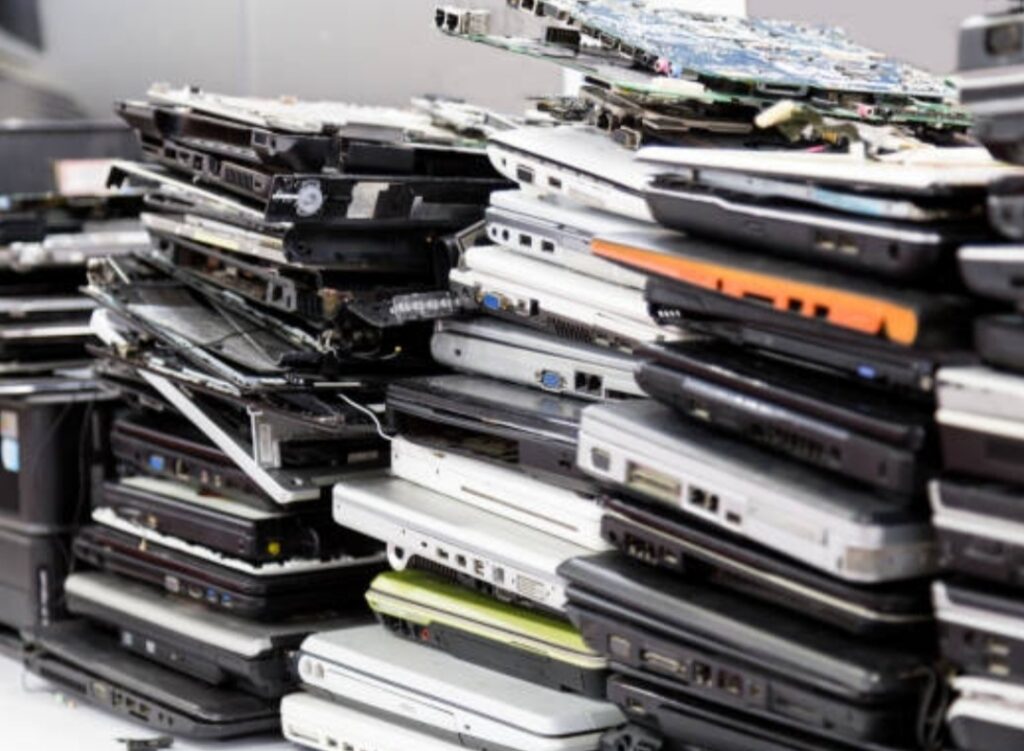
Handling Batteries and Hazardous Components
Identifying Hazardous Materials
Many electronic devices contain hazardous materials that require special disposal methods to prevent environmental damage and health risks.
- Lithium-ion batteries, commonly found in smartphones, laptops, and tablets, can cause fires or explosions if not disposed of properly.
- Lead-acid batteries, used in older electronics and automotive applications, contain toxic lead and sulfuric acid that can leach into the soil and groundwater.
- Mercury, often present in older LCD screens, fluorescent lamps, and thermometers, is highly toxic and must be handled with care.
- Cadmium, found in nickel-cadmium (NiCd) batteries, is a carcinogenic metal that poses serious health hazards.
- Polychlorinated biphenyls (PCBs), used in older electrical equipment, are harmful chemicals that persist in the environment.
Recognizing these hazardous materials is the first step in ensuring safe disposal and protecting the environment from contamination.
Safe Disposal Practices
Proper disposal of hazardous components is crucial for both personal safety and environmental sustainability.
- Use designated drop-off points: Many local governments and electronics retailers have battery recycling programs where you can safely dispose of hazardous materials.
- Never throw batteries in household trash: This can lead to fires in landfills and harm the environment.
- Check for manufacturer take-back programs: Some companies, such as Apple and Samsung, offer recycling programs for batteries and other hazardous materials.
- Follow local e-waste regulations: Different regions have strict laws on how hazardous materials should be handled and disposed of.
- Seal and label hazardous waste: If required to store hazardous components before disposal, keep them in a safe, labeled container to prevent leaks.
By following these safety measures, you ensure responsible e-waste disposal and contribute to a cleaner planet.
Recycling Large Appliances
Challenges with Large Items
Disposing of large appliances such as refrigerators, washing machines, and air conditioners presents unique challenges.
- Size and weight: These appliances are bulky and heavy, making transportation difficult.
- Harmful refrigerants: Refrigerators and air conditioners contain ozone-depleting substances (ODS) like Freon, which require special handling.
- Mixed materials: Large appliances contain a combination of metals, plastics, and electronic components, requiring specialized recycling methods.
- Regulatory restrictions: Many countries and states have strict disposal laws for large household appliances, preventing them from being dumped in landfills.
Available Services
Several options exist to safely recycle large appliances without harming the environment.
- Retailer haul-away programs: Many major retailers, such as Best Buy, Home Depot, and Lowe’s, offer appliance haul-away services when you purchase a new unit.
- Municipal bulk waste collection: Some cities provide special pickup services for large appliances, ensuring they are properly recycled.
- Certified recycling centers: Organizations like the EPA’s Responsible Appliance Disposal (RAD) program help ensure that appliances are processed safely.
- Scrap metal yards: Some scrap yards accept large appliances, allowing parts to be reused and raw materials to be recycled.
Before disposing of large appliances, always check with local services to determine the most responsible and convenient recycling method.
By following these best practices, you can reduce electronic waste, minimize pollution, and ensure that valuable materials are recovered and reused.
Remember, making informed choices about how to dispose electronics waste safely benefits both the environment and future generations.
Global Perspectives on E-Waste Recycling
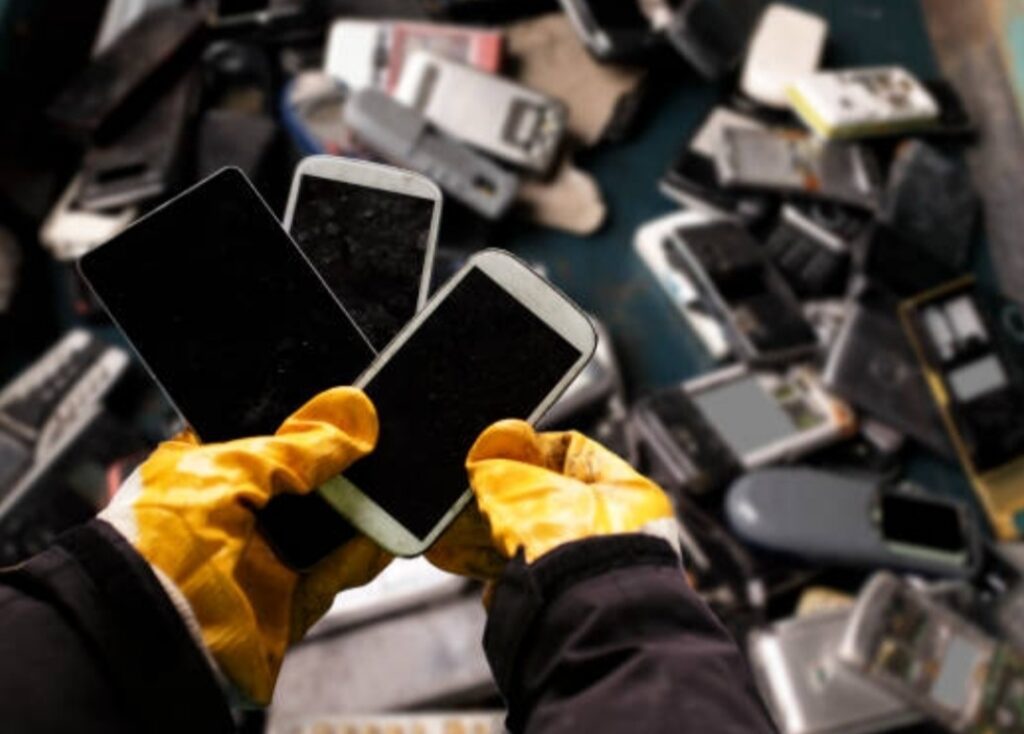
International E-Waste Management Practices
Electronic waste, or e-waste, is a growing global concern as the demand for new technology rises.
Many countries have developed their own e-waste management practices to address the increasing volume of discarded electronics.
Understanding these international efforts can provide valuable insights into how to dispose electronics waste safely while minimizing environmental harm.
Case Studies from Various Countries
Each country approaches e-waste recycling differently, depending on its economic, environmental, and regulatory landscape.
1. European Union – The WEEE Directive
The Waste Electrical and Electronic Equipment (WEEE) Directive is one of the world’s most comprehensive e-waste management laws.
- It mandates manufacturers to take responsibility for the disposal and recycling of their products.
- Consumers can return old electronics to retailers for free recycling.
- The EU has strict recycling targets, aiming to recover valuable materials like gold, silver, and rare earth metals from electronic devices.
- This model ensures that e-waste does not end up in landfills and promotes sustainable resource use.
2. Japan – The Home Appliance Recycling Law
Japan follows a circular economy approach, focusing on reusing and repurposing materials.
- Consumers pay a recycling fee when disposing of appliances like refrigerators, washing machines, and air conditioners.
- Manufacturers are responsible for collecting and recycling materials.
- Japan’s efficient system has high recycling rates, ensuring that hazardous materials like lead and mercury are properly handled.
3. United States – State-Based E-Waste Laws
The U.S. does not have a federal e-waste law, but individual states have implemented regulations.
- California’s Electronic Waste Recycling Act requires retailers to charge an advance recycling fee (ARF) to fund proper disposal.
- Other states, such as New York and Washington, have e-waste take-back programs where manufacturers must provide free recycling.
- However, only 25 states have e-waste regulations, leading to inconsistent disposal practices nationwide.
4. India – E-Waste (Management) Rules
India, one of the world’s largest e-waste producers, introduced the E-Waste Management Rules in 2016.
- The law enforces Extended Producer Responsibility (EPR), requiring manufacturers to handle the disposal of their products.
- Informal recycling, often performed by unregulated scrap dealers, remains a challenge.
- The government is working to formalize e-waste recycling by promoting certified recyclers and awareness campaigns.
Lessons Learned
Analyzing these global case studies reveals several best practices that can be applied worldwide.
1. Implementing Manufacturer Take-Back Programs
- Many successful countries mandate manufacturers to take responsibility for their products’ disposal.
- This reduces electronic waste pollution and encourages the use of eco-friendly materials.
2. Educating Consumers on Proper E-Waste Disposal
- Public awareness campaigns help people understand how to dispose electronics waste safely and responsibly.
- Schools, businesses, and retailers should promote safe e-waste recycling methods to encourage better participation.
3. Strengthening Government Regulations
- Countries with strict e-waste recycling laws tend to have higher recycling rates and lower environmental contamination.
- Governments should impose fines and incentives to encourage compliance from both consumers and businesses.
4. Investing in E-Waste Recycling Infrastructure
- Building more certified recycling facilities ensures proper handling of hazardous materials.
- Investment in advanced recycling technologies can help extract valuable metals while reducing toxic waste.
5. Promoting Circular Economy Models
- Extending product lifespans through repair, refurbishment, and reuse can significantly reduce e-waste generation.
- Incentivizing businesses to design modular, repairable electronics will create a sustainable tech industry.
The global fight against e-waste pollution requires collaboration between governments, manufacturers, and consumers.
By adopting successful international recycling strategies, countries can reduce environmental damage and recover valuable resources.
Understanding how to dispose electronics waste safely is not just an individual responsibility—it’s a collective effort for a greener future.
Frequently Asked Questions on How to Dispose Electronics Waste Safely (FAQs)
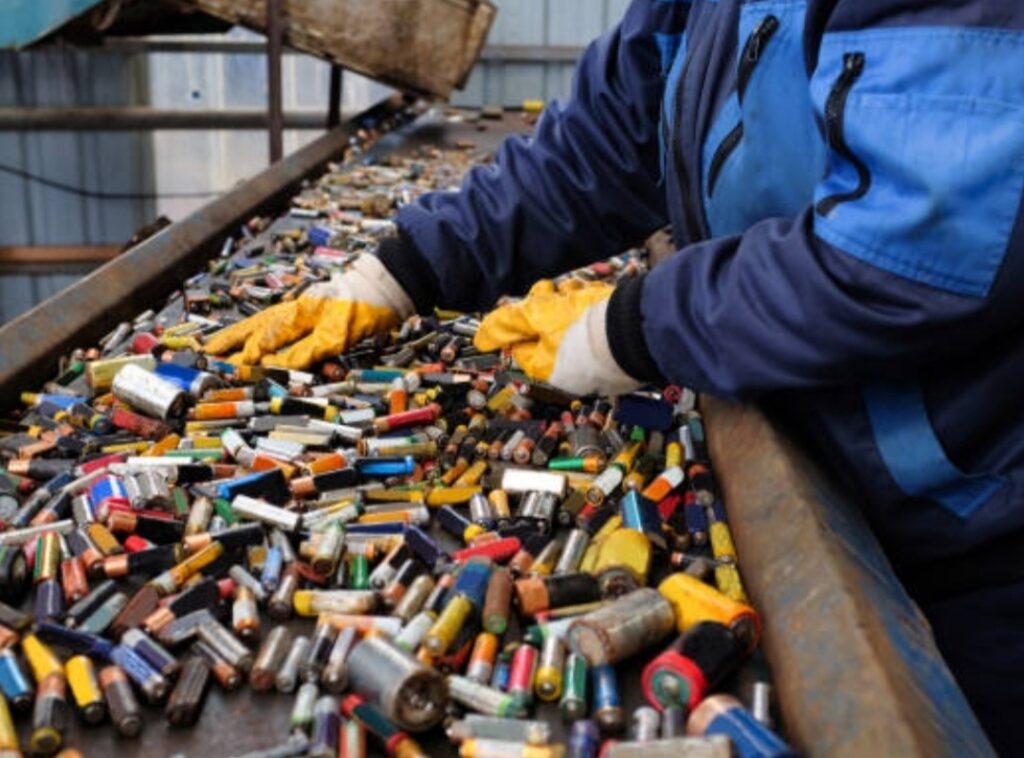
What Should I Do Before Recycling My Electronics?
Before recycling any electronic device, it is crucial to protect your personal information and prepare the device properly.
Many electronics, including smartphones, laptops, tablets, and external drives, store sensitive data that could be accessed if not properly erased.
Steps to Securely Wipe Data Before Recycling
1. Smartphones & Tablets:
- Back Up Your Data: Use cloud storage (Google Drive, iCloud) or an external device to save important files, contacts, and photos.
- Sign Out of All Accounts: Ensure you are logged out of services like Google, iCloud, Apple ID, and any linked apps.
- Factory Reset: On Android, go to Settings > System > Reset Options > Erase All Data. On iPhones, go to Settings > General > Transfer or Reset iPhone > Erase All Content and Settings.
- Remove the SIM and SD Card: These may contain additional personal data.
2. Laptops & Desktops:
- Back Up Files: Transfer documents, photos, and settings to an external hard drive or cloud service.
- Encrypt Your Hard Drive: Use BitLocker (Windows) or FileVault (Mac) for extra security before wiping data.
- Perform a Secure Erase: Reinstall the operating system or use third-party tools like DBAN (Darik’s Boot and Nuke) for a complete wipe.
- Remove or Destroy Hard Drives: If you are particularly concerned about data security, physically removing the hard drive ensures your data is inaccessible.
3. Smart Home Devices & Wearables:
- Unlink from Accounts: Disconnect from Wi-Fi, Bluetooth, and cloud services.
- Reset to Factory Defaults: Follow the manufacturer’s instructions to erase all personal data.
- Remove Any Stored Payment Information: Some smart devices store payment details that must be deleted before disposal.
By taking these precautionary measures, you can safely recycle your devices without risking identity theft or data breaches.
Can I Throw Electronics in the Regular Trash?
No, electronics should never be thrown in the regular trash.
Many electronic devices contain hazardous materials like lead, mercury, cadmium, and arsenic, which can leach into the environment if disposed of improperly.
Why Electronics Should Not Be Thrown Away
- Environmental Hazards:
- When electronics break down in landfills, they release toxic chemicals into the soil and water supply.
- Lead and mercury contamination can pose severe health risks to humans and wildlife.
- When electronics break down in landfills, they release toxic chemicals into the soil and water supply.
- E-Waste Pollution Crisis:
- The world generates over 50 million metric tons of e-waste each year, and much of it is improperly discarded.
- Dumping electronics in the trash contributes to illegal e-waste dumping in developing countries.
- The world generates over 50 million metric tons of e-waste each year, and much of it is improperly discarded.
- Missed Recycling Opportunities:
- Electronics contain valuable materials like gold, silver, copper, and rare earth metals, which can be recovered and reused.
- Proper e-waste recycling helps conserve natural resources and reduces the need for mining.
- Electronics contain valuable materials like gold, silver, copper, and rare earth metals, which can be recovered and reused.
Proper Disposal Alternatives
Instead of throwing electronics away, consider these options:
- Use Manufacturer Take-Back Programs – Many brands offer free recycling for old devices.
- Drop Off at E-Waste Collection Centers – Check with your local municipality for designated e-waste disposal locations.
- Donate Working Devices – If your electronics are still functional, consider donating them to charities or schools.
Are There Any Costs Associated with Electronics Recycling?
The cost of recycling electronics varies depending on location, device type, and the recycling program used.
Free E-Waste Recycling Options
- Retailer Take-Back Programs:
- Many stores, including Best Buy, Staples, and Apple, offer free e-waste recycling for specific electronics.
- Many stores, including Best Buy, Staples, and Apple, offer free e-waste recycling for specific electronics.
- Manufacturer Trade-In Programs:
- Some brands, like Dell, HP, and Samsung, provide free recycling or trade-in discounts for returning old devices.
- Some brands, like Dell, HP, and Samsung, provide free recycling or trade-in discounts for returning old devices.
- Local Government E-Waste Drop-Off Events:
- Many cities and towns organize free electronics recycling events to help residents dispose of devices responsibly.
Potential Recycling Fees
- Recycling Fees for Large Electronics:
- Some states charge an Electronic Waste Recycling Fee (EWRF) for larger devices like TVs and monitors.
- Fees typically range from $10 to $50, depending on the size and type of the device.
- Some states charge an Electronic Waste Recycling Fee (EWRF) for larger devices like TVs and monitors.
- Battery Recycling Costs:
- Some hazardous materials, like lithium-ion batteries, require special handling, which may come with a small disposal fee.
- Some hazardous materials, like lithium-ion batteries, require special handling, which may come with a small disposal fee.
Before disposing of electronics, check with local recyclers or retailers to determine if any costs apply.
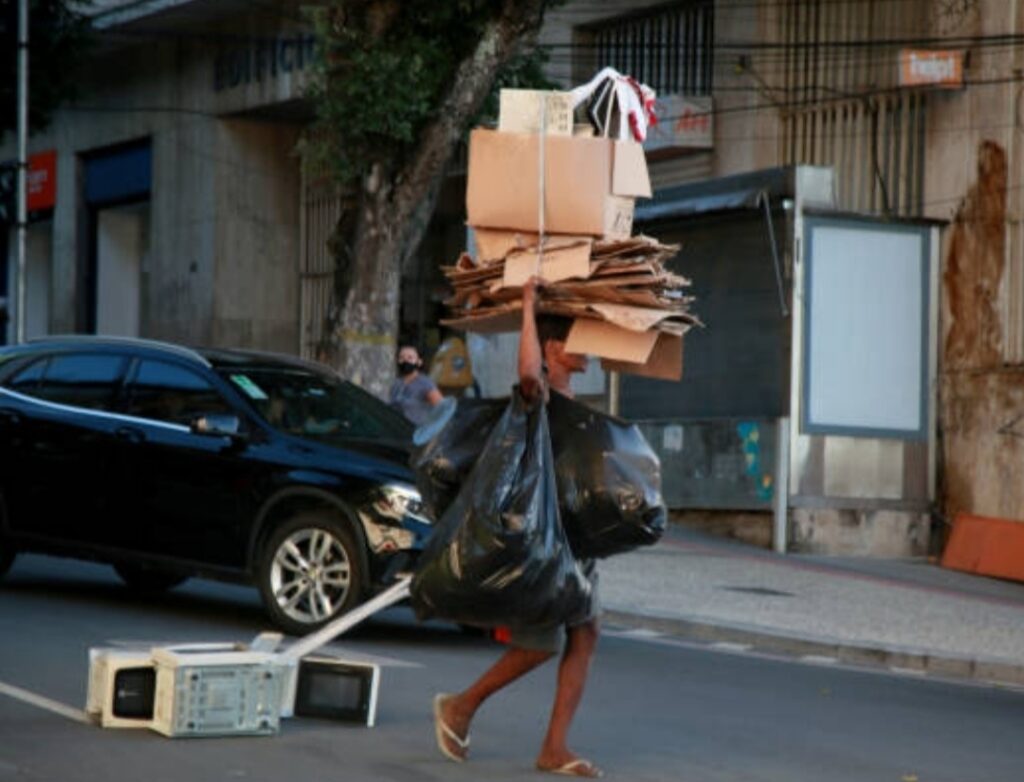
How Can I Find a Certified E-Waste Recycler Near Me?
Finding a certified electronics recycler ensures your devices are disposed of safely and ethically.
Best Resources to Locate an E-Waste Recycler
- Earth911 – A database of local e-waste recycling centers in the U.S.
- e-Stewards – Lists certified recyclers that follow strict environmental guidelines.
- Call2Recycle – Specializes in battery and cellphone recycling.
- State & Local Government Websites – Many municipalities have designated e-waste collection programs.
What to Look for in a Certified Recycler
- R2 (Responsible Recycling) Certification – Ensures recyclers follow safe and eco-friendly disposal practices.
- e-Stewards Certification – Guarantees that e-waste is not illegally dumped in developing countries.
- Transparent Recycling Process – Choose facilities that provide clear documentation on how they handle materials.
What Happens to Electronics After They Are Recycled?
Once collected, electronic devices go through a multi-step recycling process to recover valuable materials and safely dispose of hazardous components.
Step-by-Step E-Waste Recycling Process
1. Collection & Sorting
- Devices are sorted by type (laptops, smartphones, TVs, etc.) before processing.
- Items are checked for reuse potential, with working devices often being refurbished and resold.
2. Dismantling & Hazardous Material Removal
- Batteries, mercury-containing parts, and circuit boards are carefully removed to prevent toxic contamination.
- Screens, which often contain lead and cadmium, are safely separated.
3. Shredding & Material Separation
- Electronics are mechanically shredded into small pieces.
- Magnets and filters separate materials like metals, plastics, and glass for further processing.
4. Refining & Reuse
- Extracted precious metals like gold and silver are sent to specialized facilities for reuse.
- Plastics and aluminum are melted down and repurposed for manufacturing new electronics or consumer products.
Why E-Waste Recycling Matters
- Reduces landfill waste and prevents toxic contamination.
- Conserves natural resources by recovering valuable metals.
- Supports the circular economy by promoting reuse and sustainable manufacturing.
Recycling electronics is a responsible and necessary step to reduce e-waste pollution.
By understanding How to dispose electronics waste safely, you can help protect the environment and ensure valuable materials are repurposed efficiently.
Don’t let your old devices end up in landfills—choose a certified e-waste recycler today!
Conclusion of How to Dispose Electronics Waste Safely
As the world continues to advance technologically, proper e-waste disposal is becoming more important than ever.
Every year, millions of tons of discarded electronic devices end up in landfills, polluting the environment and wasting valuable resources.
By understanding how to dispose electronics waste safely, we can all play a crucial role in reducing electronic waste pollution and promoting sustainability.

Why Responsible Electronics Disposal Matters
Many people are unaware of the harmful effects of e-waste on the environment.
Throwing electronics in the trash poses serious risks, including:
- Toxic Chemical Contamination: Lead, mercury, and other hazardous substances from batteries, circuit boards, and screens can seep into soil and water, endangering human and animal health.
- Air Pollution from Incineration: Burning e-waste releases dangerous toxins, contributing to air pollution and respiratory diseases.
- Waste of Precious Resources: Electronics contain gold, silver, copper, and rare earth metals that can be recycled and reused rather than being lost in landfills.
By choosing eco-friendly disposal methods, we can protect the planet, conserve natural resources, and create a more sustainable future.
The Best Ways to Dispose of Electronics Responsibly
There are several safe and responsible ways to get rid of unwanted electronic devices.
Instead of throwing old gadgets in the trash, consider these eco-friendly options:
- Recycle Your Electronics Through Certified E-Waste Programs
- Find a certified e-waste recycling center near you using resources like Earth911 or e-Stewards.
- Many manufacturers and retailers offer electronics take-back programs for free or at a low cost.
- Find a certified e-waste recycling center near you using resources like Earth911 or e-Stewards.
- Donate or Sell Usable Devices
- If your device still works, donate it to a school, charity, or nonprofit organization.
- You can also sell old electronics on platforms like eBay, Facebook Marketplace, or Gazellea for extra cash.
- If your device still works, donate it to a school, charity, or nonprofit organization.
- Trade-In Programs for Upgrading Electronics
- Many brands, including Apple, Samsung, and Dell, offer trade-in programs where you can exchange old devices for discounts on new purchases.
- Many brands, including Apple, Samsung, and Dell, offer trade-in programs where you can exchange old devices for discounts on new purchases.
- Repair Instead of Replacing
- Instead of throwing away a broken device, consider getting it repaired.
- Small issues like cracked screens, battery replacements, or slow performance can often be fixed at a lower cost than buying a new device.
- Instead of throwing away a broken device, consider getting it repaired.
Make E-Waste Disposal a Priority
Every decision you make about electronic waste disposal has an impact on the environment.
By choosing responsible e-waste recycling and avoiding landfill disposal, you are helping to:
✔ Reduce toxic waste and pollution
✔ Conserve valuable materials for future use
✔ Protect the environment and human health
So, before you get rid of your old phone, laptop, or tablet, ask yourself: “Am I disposing of this responsibly?”
If the answer is no, now is the time to take action!
Do Your Part Today!
Don’t let your old electronics end up in a landfill.
Take the next step by finding a certified e-waste recycler, donating your unused devices, or exploring trade-in options.
⚡ Make the commitment today to dispose of electronics safely and sustainably! ⚡
You might also like :

